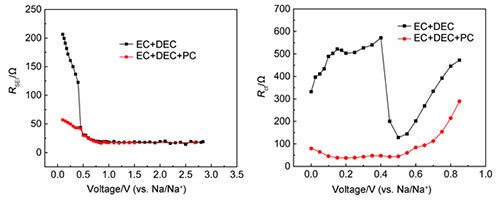| [1] Tarascon, J. M. Nat. Chem. 2010, 2, 510.
[2] Xiang, X. D.; Lu, Y. Y.; Chen, J. Acta Chim. Sinica 2017, 75, 154. (向兴德, 卢艳莹, 陈军, 化学学报, 2017, 75, 154.)
[3] Vikström, H.; Davidsson, S.; Höök, M. Appl. Energy 2013, 110, 252.
[4] Kundu, D.; Talaie, E.; Duffort, V.; Nazar, L. F. Angew. Chem., Int. Ed. 2015, 54, 3431.
[5] Li, H.; Wang, Z.; Chen, L.; Huang, X. Adv. Mater. 2009, 21, 4593.
[6] Komaba, S.; Murata, W.; Ishikawa, T.; Yabuuchi, N.; Ozeki, T.; Nakayama, T.; Ogata, A.; Gotoh, K.; Fujiwara, K. Adv. Funct. Mater. 2011, 21, 3859.
[7] Zhang, S. W.; Zhang, J.; Wu, S. D.; Lv, W.; Kang, F. Y.; Yang, Q. H. Acta Chim. Sinica 2017, 75, 163. (张思伟, 张俊, 吴思达, 吕伟, 康飞宇, 杨全红, 化学学报, 2017, 75, 163.)
[8] Wang, L.; Yang, G. R.; Wang, J. N.; Wang, S. L.; Peng, S. J.; Yan, W. Acta Chim. Sinica 2018, 76, 666. (王玲, 杨国锐, 王嘉楠, 王思岚, 彭生杰, 延卫, 化学学报, 2018, 76, 666.)
[9] Narayanrao, R.; Joglekar, M.; Inguva, S. J. Electrochem. Soc. 2013, 160, A125.
[10] Lin, X.; Park, J.; Liu, L.; Lee, Y.; Sastry, A.; Lu, W. J. Electrochem. Soc. 2013, 160, A1701.
[11] Pinson, M. B.; Bazant, M. Z. J. Electrochem. Soc. 2013, 160, A243.
[12] Xu, K. Chem. Rev. 2014, 114, 11503.
[13] Zhuang, Q. C.; Xu, S. D.; Qiu, X. Y.; Cui, Y. L.; Fang, L.; Sun, S. G. Prog. Chem. 2010, 22, 1044. (庄全超, 徐守冬, 邱祥云, 崔永丽, 方亮, 孙世刚, 化学进展, 2010, 22, 1044.)
[14] Qin, Y. P.; Zhuang, Q. C.; Shi, Y. L.; Jiang, L.; Sun, Z.; Sun, S. G. Prog. Chem. 2011, 23, 390. (秦银平, 庄全超, 史月丽, 江利, 孙智, 孙世刚, 化学进展, 2011, 23, 390.)
[15] Qiu, X. Y.; Zhuang, Q. C.; Zhang, Q. Q.; Cao, R.; Ying, P. Z.; Qiang, Y. H.; Sun, S. G. Phys. Chem. Chem. Phys. 2012, 14, 2617.
[16] Zhuang, Q. C.; Wei, T.; Du, L. L.; Cui, Y. L.; Fang, L.; Sun, S. G. J. Phys. Chem. C 2010, 114, 8614.
[17] Qiu, X. Y.; Zhuang, Q. C.; Zhang, Q. Q.; Cao, R.; Qiang, Y. H.; Ying, P. Z.; Sun, S. G. J. Electroanal. Chem. 2012, 687, 35.
[18] Wei, T.; Zhuang, Q. C.; Wu, C.; Cui, Y. L.; Fang, L.; Sun, S. G. Acta Chim. Sinica 2010, 68, 1481. (魏涛, 庄全超, 吴超, 崔永丽, 方亮, 孙世刚, 化学学报, 2010, 68, 1481.)
[19] Zhuang, Q. C.; Wei, T.; Wei, G. Z.; Dong, Q. F.; Sun, S. G. Acta Chim. Sinica 2009, 67, 2184. (庄全超, 魏涛, 魏国祯, 董全峰, 孙世刚, 化学学报, 2009, 67, 2184.)
[20] Zheng, M.; Liu, Y.; Xiao, Y.; Zhu, Y.; Guan, Q.; Yuan, D.; Zhang, J. J. Phys. Chem. C 2009, 113, 8455.
[21] Cao, Y.; Xiao, L.; Sushko, M. L.; Wang, W.; Schwenzer, B.; Xiao, J.; Nie, Z.; Saraf, L. V.; Yang, Z.; Liu, J. Nano Lett. 2012, 12, 3783.
[22] Li, Y.; Hu, Y. S.; Titirici, M. M.; Chen, L.; Huang, X. Adv. Energy Mater. 2016, 6, 1600659.
[23] Liu, P.; Li, Y.; Hu, Y. S.; Li, H.; Chen, L.; Huang, X. J. Mater. Chem. A 2016, 4, 13046.
[24] Holzapfel, M.; Martinent, A.; Alloin, F.; Le Gorrec, B.; Yazami, R.; Montella, C. J. Electroanal. Chem. 2003, 546, 41.
[25] Chang, Y. C.; Sohn, H. J. J. Electrochem. Soc. 2000, 147, 50.
[26] Levi, M.; Aurbach, D. J. Phys. Chem. B 1997, 101, 4630.
[27] Xu, S. D.; Zhuang, Q. C.; Tian, L. L.; Qin, Y. P.; Fang, L.; Sun, S. G. J. Phys. Chem. C 2011, 115, 9210.
[28] Zhuang, Q. C.; Li, J.; Tian, L. L. J. Power Sources 2013, 222, 177. |
